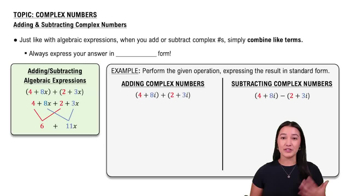Table of contents
- 0. Review of College Algebra4h 43m
- 1. Measuring Angles39m
- 2. Trigonometric Functions on Right Triangles2h 5m
- 3. Unit Circle1h 19m
- 4. Graphing Trigonometric Functions1h 19m
- 5. Inverse Trigonometric Functions and Basic Trigonometric Equations1h 41m
- 6. Trigonometric Identities and More Equations2h 34m
- 7. Non-Right Triangles1h 38m
- 8. Vectors2h 25m
- 9. Polar Equations2h 5m
- 10. Parametric Equations1h 6m
- 11. Graphing Complex Numbers1h 7m
1. Measuring Angles
Angles in Standard Position
Problem 45c
Textbook Question
Perform each calculation. See Example 3. 90° ― 51° 28'
 Verified step by step guidance
Verified step by step guidance1
Convert the angle 51° 28' into decimal degrees. To do this, divide the minutes by 60 since there are 60 minutes in a degree.
Subtract the decimal degree equivalent of 51° 28' from 90°.
If necessary, convert the result back into degrees and minutes by taking the decimal part and multiplying by 60 to get the minutes.
Ensure the final answer is in the correct format, either in decimal degrees or degrees and minutes.
Double-check the subtraction to ensure accuracy in the conversion and calculation steps.
Recommended similar problem, with video answer:
 Verified Solution
Verified SolutionThis video solution was recommended by our tutors as helpful for the problem above
Video duration:
1mPlay a video:
Was this helpful?
Key Concepts
Here are the essential concepts you must grasp in order to answer the question correctly.
Angle Measurement
Angles can be measured in degrees and minutes, where 1 degree equals 60 minutes. In this context, the angle is expressed as 51 degrees and 28 minutes, which is a common way to represent angles in trigonometry. Understanding how to convert between degrees and minutes is essential for accurate calculations.
Recommended video:

Reference Angles on the Unit Circle
Subtraction of Angles
Subtracting angles involves taking one angle measurement away from another. When performing this operation, it is important to align the degrees and minutes correctly. If the minutes of the angle being subtracted exceed those of the angle from which it is being subtracted, borrowing from the degrees may be necessary.
Recommended video:

Adding and Subtracting Complex Numbers
Complementary Angles
Two angles are complementary if their sum equals 90 degrees. In this problem, the calculation involves finding the complement of 51 degrees and 28 minutes. Recognizing the relationship between complementary angles is crucial for solving problems that involve angle subtraction and understanding their geometric implications.
Recommended video:

Intro to Complementary & Supplementary Angles

 5:50m
5:50mWatch next
Master Drawing Angles in Standard Position with a bite sized video explanation from Patrick Ford
Start learningRelated Videos
Related Practice













